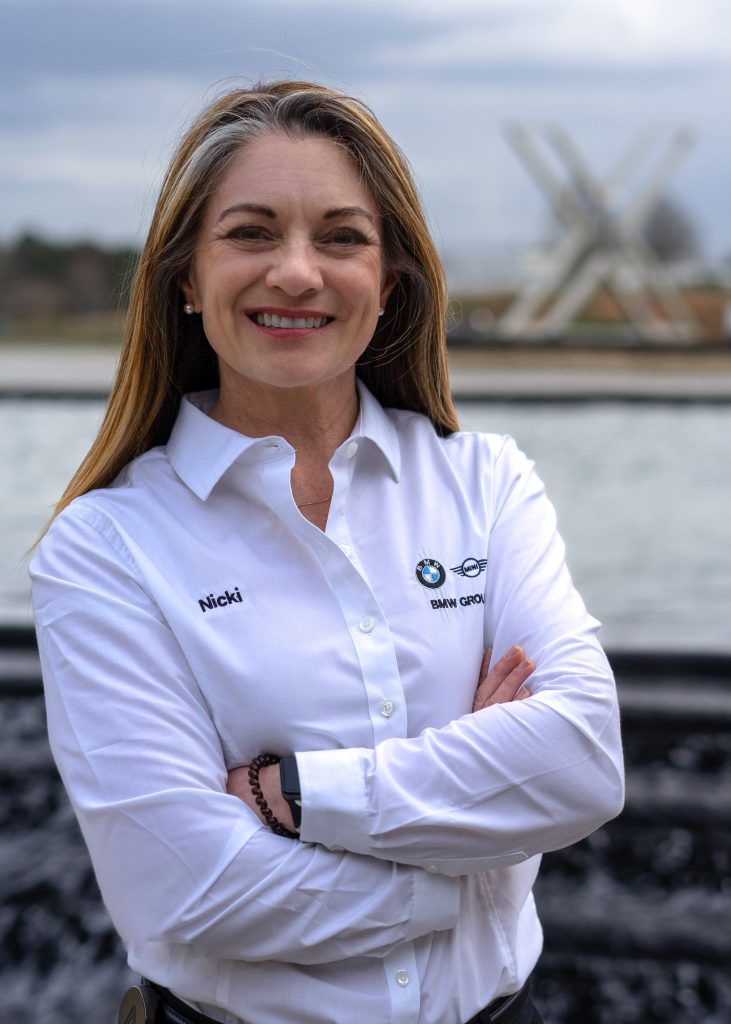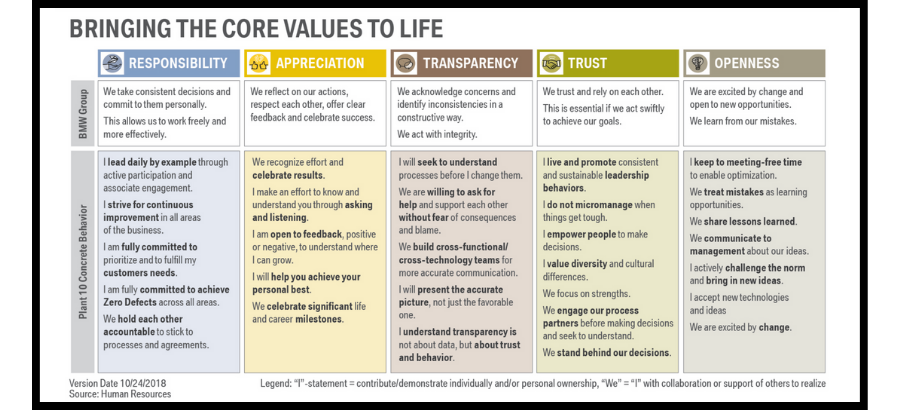
BMW has long stood as the epitome of automotive luxury and performance. At their manufacturing plant in Spartanburg, South Carolina, their commitment to excellence extends far beyond the vehicles that roll off their production lines. They are equally passionate about developing and supporting their leaders from the frontline up.
 The BMW Spartanburg plant assembles more than 1,500 X Model vehicles each day, resulting in an impressive annual production of over 416,000 units in 2022; this includes all X5 and X7 models.
The BMW Spartanburg plant assembles more than 1,500 X Model vehicles each day, resulting in an impressive annual production of over 416,000 units in 2022; this includes all X5 and X7 models.
The plant’s performance hinges on leadership from nearly 600 leaders—315 frontline supervisors, 265 managers, and 15 board-level executives. At the “driver’s seat” of the Spartanburg plant’s leadership development is Nicki Creech, their Leadership and Transformation Specialist.
At the heart of Creech’s success is her ability to build programs that change behavior. Leaders at BMW don’t just “learn” about critical topics. They also “get feedback” from simulated, hyper-realistic scenarios and then “practice” key concepts.
Here’s how she does it.

Trust Is the Foundation of Creech’s Approach to Leadership Development
If you're clear about your program’s intention, transparent about your expectations, and you build trust, it almost doesn't matter what your content is. You will still get where you need to go. —Nicki Creech, Leadership and Transformation Specialist at BMW Manufacturing
For Creech, trust is foundational to effective leadership development. To illustrate this, she told a quick story:
“At the end of a long day of work, I was talking one-on-one with another manager. She pointed out that I had something in my teeth. At first, I was embarrassed, but when I reached down to grab my toothbrush, I realized I hadn’t eaten anything in six hours. I had several conversations and interactions all over the plant. …. And not one person pointed out the big piece of pepper in my teeth. I thought to myself, why didn’t anyone let me know? Did they not care about me, or have I not earned their trust? Do they feel like I would react poorly?”
Creech then pointed out how this scenario is applied to leadership development. If everyone knows your leadership isn’t effective, but no one tells you, how do you know you need to change? “The analogy I like to make is that leadership behavior can be seen in the exact same way. How you lead people and behave often comes down to one little idiosyncrasy. Maybe it's how you treat people, or you're always late to meetings, or the fact that you speak in a very abrupt way. Everybody knows it, but no one brings it up as an opportunity for development because it's uncomfortable to talk about. As people developers, we don't have that freedom. We must have those conversations. We have 315 frontline supervisors who need the skills to drive those conversations with their direct reports and their managers.” For that reason when Creech came on board, she made “trust” a central operating principle as she designed their frontline leadership program, “iLEAD.”
Specifically, Creech conducted a thorough and human-involved gap analysis:
- She read through associate survey feedback from 2013-2019.
- She looked at training needs analysis and what courses were offered in the past.
- She shadowed and interviewed frontline supervisors.
- She ran her ideas by the supervisors to get buy-in.
By involving the supervisors themselves, Creech gathered practical information (like the challenges supervisors faced on the job). She also built trust and buy-in from the program’s inception.
Feedback: Simulation Exercises Help Identify Skill Gaps
Being a frontline supervisor is one of the most difficult leadership jobs in manufacturing. Two of the most common challenges include:
- Each supervisor oversees a large team of 30 to 50 individuals and reports to a manager.
- The promotion of these supervisors often relies heavily on their technical skills, sometimes overshadowing the equally critical people skills needed in their roles.
To identify specific development opportunities, each supervisor completed a Leadership Assessment simulation exercise prior to the iLEAD program.
Here’s one example of a simulation used with frontline supervisors: You have a high-performing associate whom you could see developing into a supervisor. But you noticed that their performance has dropped, and they're not volunteering to come in on weekend shifts like they used to. You have two upcoming weekend shifts that you need to fill. Nobody else on the team can fill them. You need to ask this person to fill these shifts for you. How do you start the conversation?
Creech elaborated, saying, “What we look for is, which topic is addressed first? Do they fulfill their personal need as the section leader to get the shift filled? Or do they ask a question to understand and learn why performance is declining with their associate and address the associate’s needs?” Do they coach, or do they demand?
After the simulation, leaders walk away with specific feedback about where they need to develop.
Learn: The “iLEAD ” Modules Help Prepare Frontline Leaders for Success
Equipped with the supervisors' input & identified skills gaps, Creech built a frontline leader program that was highly tailored to the challenges they faced.
To help frontline supervisors overcome their challenges, Creech designed a six-month, cohort-based program with three key modules. Each module consists of two days of experiential learning followed by a six-week period devoted to on-the-job application:
- Module #1: Thinking: – This module helps supervisors uncover their purpose and personal core values, therefore fostering a deeper understanding of how these aspects connect with BMW's own core values (pictured below). “The very first module was very unconventional for what you might see in a manufacturing plant,” Creech said. “It took some time to uncover things like: What are your personal core values? How do they show up in what you're currently doing? And can you connect your personal core values to our BMW core values? So this first module is very raw and helps develop trust amongst the cohort.”
- Module #2: Collaboration: – Creech pointed out that Emotional Intelligence (EQ) was the one area where they saw the biggest gaps. Their program focuses on the neuroscience behind emotions and how a leader’s ability to recognize, understand, and manage their emotions drives trust with their direct reports and their teams. The module focus is collaborating across boundaries and building authentic relationships.
- Module #3: Coaching – “When I came to BMW,” Creech said, ”there was a 1-day coaching class focused on the GROW model, but most participants didn’t apply what they learned. More so, they would give up after one attempt because it wasn’t natural for them.” As a Professional Certified Coach, Creech knew there were certain skills needed to bring the model to life. She said, “I kept the GROW model but focused on curiosity, active listening, powerful questions, and ‘asking, not telling.’ This generated more in-the-moment coaching.”
Six weeks after the third module, the supervisors reconvene for a capstone presentation. Each participant shares their experience, transformation as a leader, feedback from their team members, and the impact they've made on the business. The capstone is not just a recounting of experiences. It’s a storytelling opportunity guided by a template that encourages creativity in sharing their leadership journey. For example, the story might include a specific incident, like how the leader handled a line shutdown differently due to their new leadership skills.

Practice: BMW Helps Leaders Turn Knowledge into Habits Using Thoughtful Resources
Creech was quick to point out the significance of getting leaders to take what they learned and apply it on the job. “I don't think one program is going to make all the change that people want to see. A leadership program is just a class. I can't go to a football class and then go out and play great football. I may know what a 4-3 defense is, but it does not make me a linebacker. In the same way, you can't expect people to attend a leadership program and then instantly become a great leader.”
After each two-day module, Creech sets leaders up to apply what they learned. “I want to try and provide as many resources as possible to help people learn by doing.” For frontline supervisors, these resources cover the following:
- An action plan for what & how they’ll practice in the flow of work.
- Identify what support they need and who can help them.
- Group Coaching sessions for follow-up and accountability.
- Match with someone to mentor and reinforce what was learned through teaching back.
These resources set up frontline leaders to practice what they learned before they dive into the next module.
“Feedback, Learn, Practice:” A Blueprint for Highly Effective Leadership Development
BMW Plant Spartanburg's distinctive leadership development program offers a profound blueprint for leadership development professionals. With the unique blend of development feedback from realistic simulation exercises, formal learning sessions, and on-the-job application, leaders are encouraged to apply their newfound skills on the job. The result is a culture of trust where candid conversations and feedback thrive, enhancing the efficacy of leadership and, ultimately, driving organizational performance.






